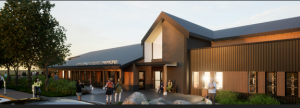While the construction industry is often considered a laggard in terms of digitization, some companies are taking technology and innovation to the next level.
In his presentation at the CSC Building Expo, hosted by the CSC Toronto Chapter, Yuri Bartzis, innovations manager, Canadian Building Operations at Pomerleau, talked about the company’s innovation strategy, optimizing the construction process and how technology is changing the way construction companies will build in the future.
3D and 4D technology and models are now a staple for the design and construction co-ordination of buildings, Bartzis explained.
“We do Lean planning on our jobsites and we also take that to the next level using digital technology and we do 4D technology,” he said.
“It’s not just for us to better understand how we are going to tackle these construction projects but to share the knowledge and the plan essentially of how we want to tackle construction. That sharing of knowledge is what is really helping us grow, helping our project team grow but also helping the industry grow because we are sharing this information with our trade partners and owners and all stakeholders on the project.”
VR technology is also being used.
“It’s not just to visualize the construction and what we are going to be building but to visualize the space around our construction sites,” said Bartzis.
“The next step for co-ordination is bringing that to the end user of these buildings…so that they can interact with the building that we are going to be building for them. Whether it’s moving chairs or opening desks, they get a better understanding of how the space is going to function and all this is to optimize the entire construction process.”
The company is also using 360-degree cameras, LIDAR scanning and drone technology to gather and analyze data.
“All the information we gather from design and construction we’re transferring that to the end user, to the owners of these facilities. We are making sure that during the design the end user understands what we are going to be building,” said Bartzis. “It confirms what we are going to build is essentially what they need in the end.”
Pomerleau is also working with innovation partners Boston Dynamics and piloting a mini robot to optimize certain processes on construction sites and to see how robotics can mix with onsite teams. They combine it with 360 cameras and other technology in order to gather data.
Internet of Things (IOT), tags and sensor technology are all being integrated on jobsites for contact tracing during the COVID-19 pandemic, Bartzis added.
Brian Kmet, senior relationship manager with PCL Construction, focused on the company’s Jobsite Insights (JSI) technology, which is used internally and is now being commercialized and offered to the construction industry and other sectors in the marketplace. The data can be used to mitigate issues which can impact schedule or budget.
“We deploy wireless IOT sensors on a jobsite that are ingested in the Jobsite Insights platform, a Cloud-based application that runs on Microsoft Azure technology,” explained Kmet. “That data is analyzed as it’s incoming and we are looking for anomalies and events or conditions on a jobsite such as freezing temperatures, water leaks, wind conditions that could impact safety. We enable an immediate jobsite response and corrective action by jobsite personnel. Their mobile devices receive alerts and notifications and in doing so we are able to improve schedule and avoid these risks and dangers on the jobsites.”
Kmet’s team is involved in advancing another product in the JSI ecosystem called Jobsite Vision, the use of computer vision and machine learning. Right now they are working on trench or excavation inspection.
“Excavations are dangerous and if they are not constructed and secured properly they can cause injury or even death,” said Kmet. “We’re now using visual analytics to examine trenches and visually detect the anomalies. Are the barricades there? Is the angle of inclination on the ramp leading into the trench sufficient or within the design parameters? Similarly, on quality, certainly we’ve had cases where, for example, the wrong size rebar was used before the pour, the pour executed and now you have to tear it up because you’ve used the incorrect material in the concrete work. We want to detect that visually with Jobsite Vision and machine learning.”
Follow the author on Twitter @DCN_Angela.











Recent Comments